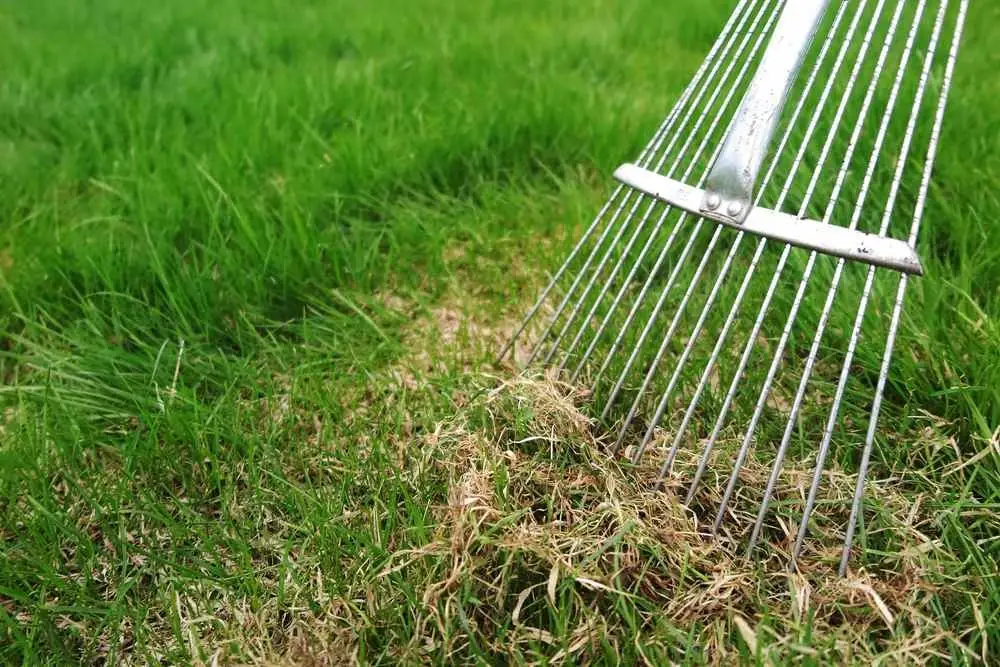You can improve the health and look of your lawn by scarifying or dethatching, but it’s important to know the difference between the two so you don’t do more harm than good.
Both of them basically clean up the lawn, but there are some important design and performance differences that can change how it looks in your backyard. A common misconception is that the machines are big, heavy, and bulky. However, scarifying and/or dethatching can be done at home with smaller, easier-to-move machines that can also fix patchy grass.
Here are some tips from lawn care pros to help you choose the right tool for the job. Even though it might look like a lot of work, using a scarifier or dethatcher the right way could make your grass greener and healthier come spring.
If your lawn is looking tired, patchy, or feeling spongy underfoot, it may need some rejuvenation. Dethatching and scarifying are two common lawn care techniques that remove debris to improve grass health. But when should you use dethatching versus scarifying?
Both aim to get rid of accumulations of dead grass, moss, and debris called thatch. Thick layers of thatch prevent proper growth by blocking water, air and nutrients from reaching the soil. Dethatching and scarifying tackle the problem in slightly different ways.
What is Dethatching?
Dethatching involves raking or powering equipment with tines across the lawn surface. The tines comb through grass blades to pull up and remove small amounts of thatch.
Dethatching is best for:
- Preventative lawn care when thatch is just starting to build up
- Lawns with thinner layers of thatch
- Frequent, gentle removal of debris
- Minimal disruption to the lawn
What is Scarifying?
Scarifying uses blades to cut down vertically into the lawn and rip out thicker thatch layers. This aggressive method leaves visible slices and grooves.
Scarifying is best for:
- Lawns with excessive thatch buildup
- Complete removal of years of debris accumulation
- Severely compromised lawns needing renovation
- Infrequent but deep cleaning
Signs Your Lawn Needs Dethatching
- Grass grows more slowly or appears thin
- Lawn feels slightly spongy underfoot
- A small amount of debris is visible when grass is cut
- Puddles form on the lawn after rain
- Moss is beginning to grow
If your lawn shows these early signs of a budding thatch problem, dethatching is probably the best solution. It gently pulls up debris before it can get too thick and cause major issues.
Signs Your Lawn Needs Scarifying
- Lawn feels very spongy and bouncy
- Excessive accumulation of dead material around grass blades
- Large bare patches or sections of dead grass
- Significant moss growth across the lawn
- Serious drainage or puddling issues after rain
Extensive moss growth, sponginess, or large dead patches indicate a thicker thatch layer has already built up. For these lawns, the aggressive scarifying method is needed to remove debris and reinvigorate grass.
When to Dethatch or Scarify Your Lawn
-
Spring – As growth resumes, dethatching or scarifying kickstarts your lawn for the season.
-
Early Fall – The ideal time, as grass recovers well from the disruption before winter dormancy.
-
Avoid summer – Heat stress makes it harder for grass to bounce back.
-
Avoid winter – Dormant grass won’t fill back in until spring.
How Often to Dethatch or Scarify
-
Dethatching – For maintenance, dethatch once or twice per year in early spring and fall. Or just when needed.
-
Scarifying – Only scarify severely thatchy lawns, every 2-3 years at most. Annual scarifying causes too much stress.
Check your lawn each season and determine if a quick dethatching or more extensive scarifying is required. Pay attention to how your grass recovers to avoid overdoing it.
Dethatching vs Scarifying: Key Differences
| Dethatching | Scarifying |
|---|---|
| Lightly combs surface to remove minor debris | Cuts vertically into lawn to remove major debris |
| Causes minimal visible damage | Visibly slices and damages lawn |
| Tines loosen and pull up thin layers | Blades rip out thick layers |
| Gently revitalizes the lawn | Aggressively renovates the lawn |
| Improves minor issues | Fixes severe thatch buildup |
| Prevents future problems | Repairs current issues |
| Use every season or as needed | Use only occasionally |
Manual Dethatching vs Power Dethatching
You can dethatch manually using a steel rake or power dethatcher:
-
Manual dethatching – Hard work but cheaper. Use a steel tine rake on small lawns.
-
Power dethatching – Electric or gas-powered dethatchers easily tackle larger lawns.
Either method provides a light dethatching for maintenance. Power dethatchers are more efficient for frequent thatch removal.
Should I Dethatch or Scarify My Lawn?
Look at your lawn’s condition and symptoms to decide whether a quick dethatching treatment or full scarifying renovation is required:
-
If your lawn just feels slightly spongy and grass growth is slowing, dethatching should improve it.
-
If you have large dead patches, excessive moss, and a very bouncy spongy lawn, scarifying is likely needed to rip out years of compacted debris.
Scarifying is more disruptive and should only be done occasionally on lawns with out-of-control thatch. Dethatching is gentler, safer for frequent use, and great for regular lawn maintenance.
Focus on preventative dethatching whenever possible to avoid the need for drastic scarifying down the road. But for lawns already engulfed by thatch, scarifying may be the only cure. Consider the specific signs your lawn is showing and choose the method that targets the problems at hand.
Revitalize Your Lawn
By understanding the differences between dethatching and scarifying, you can determine which technique is right for your lawn’s current state. Remove debris buildup before it takes hold or aggressively tackle existing thatch issues. With the proper application of dethatching and scarifying, your lawn will bounce back healthy, thick, and vibrant again in no time.
When should you scarify a lawn?
In most parts of the US, scarifying in spring or early fall is generally recommended. Scarifying the lawn at other times of the year might stop new growth, leaving it thin and patchy for a long time.
Still, some experts say scarification shouldn’t be done at all because it might do more harm than good for the lawn. The scarification process inevitably does short-term damage to the lawn, and it may also decrease the lawn’s biodiversity. When you scarify your lawn should be carefully considered. If you do decide to do it, make sure you do it when the grasses will have a window of warm weather to grow back right after.
Get the Top Ten Reviews Newsletter
Sign up to get the newest news, reviews, buying guides, and deals sent straight to your inbox. Please send me news and deals from other Future brands. You will also get emails from us on behalf of our sponsors and trusted partners.
The main difference is how long the spikes are and how they affect your lawn: “Scarifying does the same as above, but to a much greater extent, with blades that actually penetrate and cut into the soil, leaving slits in the earth.” “.

Adam, a Vlog/blogger For Webb, has over 30 years of experience as a professional gardener and has many accolades but is probably best known for his four Gold Medals at The Royal Horticultural Society’s Chelsea Flower Show in London (UK) and his three BBC/RHS People’s Choice Awards at the show (of which he is particularly proud) which he won as one half of Woolcott & Smith.
John Parker, general contractor and founder of Easy Pool Cleaning, adds that “scarifiers dont just remove the thatch; they dig deeper, taking out debris and aerating the soil.”
“Dethatchers are milder and more focused,” Parker explains. “They remove the thatch layer without delving too deep, leaving some thatch behind. ” Post-treatment, grass tends to recover faster after dethatching as compared to scarifying.
John Parker is a general contractor, a pool cleaning expert, and the founder of Easy Pool Cleaning. He spent 10 years as a general contractor before starting a successful pool cleaning business. Soon after, he expanded the scope of my services to include all manner of backyard improvement and maintenance, as well as landscaping.
Thatch, which is made up of dead grass and other natural debris, can build up on the lawn over time. It sits between the top of the grass and the roots below. While this can help keep water in and help the soil break down and grow new plants, if it gets too thick (more than half an inch), it can kill the grass by blocking water and nutrients from getting to the soil.
Sally Allsop, owner of gardening blog All That Grows, explains why you should use these tools to promote a healthier lawn.
“A scarifier is used to aerate a lawn. They made it so that water, air, and nutrients can get to the soil’s roots and kill weeds, she says. This is done with metal spikes that dig into the ground, loosening it up and making room for new grass to grow.
A dethatcher, on the other hand, is the softer approach as it doesnt go below ground. “A dethatcher is used to remove thatch from the surface,” Sally adds. It doesn’t go as deep into the ground as a scarifier, but it does help get rid of dead grass, roots, and other things that are on top of the ground.

Sally Allsop is an avid gardener and founder of the online gardening site All That Grows. All That Grows is an inspirational gardening blog, covering growing fruit, vegetables and flowers. On the site, you’ll find many useful hints and tips to help you get the most out of your garden, plus other DIY garden projects.
Whether you pick a scarifier or dethatcher largely depends on the state of your lawn. It is better to use dethatching on lawns that are already established or that are just starting out. A scarifier, on the other hand, is best for a fresh start or a lawn that is really thick and needs a rough touch.
If you already have a ride-on lawn mower then a pull-behind attachment is a great option. They can be pretty heavy, so you might find that there are more dethatcher options, like this dethatcher attachment from Brinly-Hardy.
Garden and landscaping expert Tom Su (and owner of Lawn Edging) explains when you should choose a dethatcher or scarifier. “Dethatchers are more about surface-level cleanup, removing that layer of organic debris. Scarifiers go deeper to relieve soil compaction and promote better grass root health.”
“Dethatching might need to be done more often, especially if you have grass that grows quickly or use a lot of fertilizers,” he says. Scarifying can be more of an occasional treatment, depending on your lawns needs. “.
You might want to wait to scarify your lawn until it really needs it because it is a much rougher process. Unlike dethatching, it digs deep into the soil, taking out unwanted debris and aerating the soil. Dethatching may be best if your lawn needs a quicker, gentler revival.

Tom Su is the visionary behind Lawn Edging, a brand synonymous with innovative and sustainable garden design solutions. Tom has over a decade of experience in the home and garden industry. He has dedicated his career to creating beautiful, sustainable outdoor spaces. As the owner of Lawn Edging, he specializes in high-quality lawn edging solutions that enhance the aesthetic and functional value of any garden.
Are Electric Dethatchers and Scarifiers The Same Thing
FAQ
When should you not scarify your lawn?
Does scarification remove thatch?
Should I scarify or dethatch before overseeding?
Should I scarify or rake first?
What is the difference between scarifying and dethatching?
As the blades rotate, they cut into the thatch, loosening the material and pulling it to the surface for collection. In summary, the main difference between scarifying and dethatching in the eye of manufacturers is that scarifying is a more aggressive and effective method of dethatching than regular dethatching.
Should I scarify or dethatch my lawn?
– **Frequency**: Consider dethatching when your lawn has a moderate amount of thatch. Remember that both methods contribute to a healthier lawn, so choose based on your lawn’s specific conditions and needs.
What is the difference between a scarify and a dethatch attachment?
In other words, scarifying is an attachment that cuts into the ground/thatch, and a dethatcher is an attachment that rakes the loose surface material on top of the thatch. Let’s say you have one of these types of tools that have both scarify and dethatch attachment options available.
Should I scarify or remove thatch?
Still, removing thatch by scarifying is more beneficial, especially when the soil is heavily compacted and you want to aerate the soil, too. Scarification removes thatch by pulling it out of the base of the shoots and into a collecting bag or pulling it upwards for easier removal.
- The Ultimate Guide to Growing Strawberries in Raised Beds - August 8, 2025
- No-Dig Garden Beds: The Easiest Way to Grow a Beautiful Garden - August 6, 2025
- How to Protect and Preserve Wood for Raised Garden Beds - August 6, 2025

